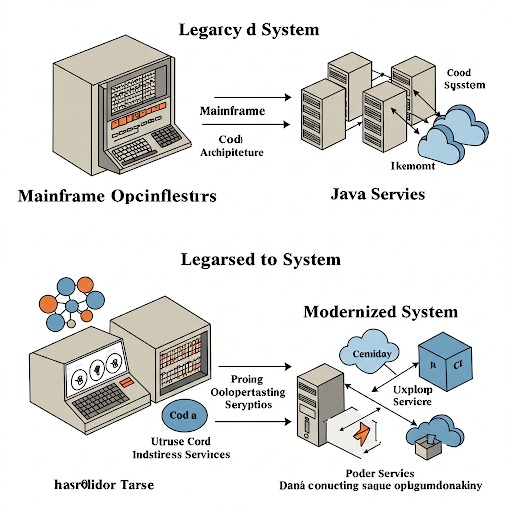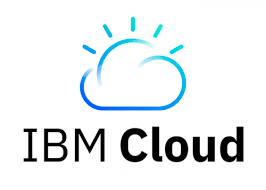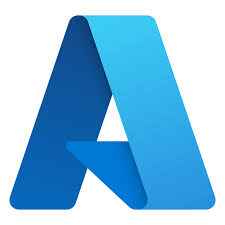Legacy Modernization
Legacy modernization refers to the process of updating, converting, or replacing legacy systems, especially older software applications, so that they continue to meet the evolving needs of an organization. A common area of focus in legacy modernization is the transition from mainframe systems to more modern platforms like Java-based environments. Mainframes have been the backbone of many large enterprises for decades. However, with changing technology landscapes, rising maintenance costs, limited flexibility, and difficulties in integrating with modern systems, many organizations are choosing to modernize their legacy systems. Transitioning from mainframes to a Java-based architecture is one of the most popular modernization strategies, leveraging the flexibility, scalability, and efficiency of modern programming languages like Java. Let’s dive deeper into legacy modernization from mainframes to Java, examining the motivations, processes, strategies, challenges, and best practices involved.

Why Choose Our Cloud Solutions?
We modernize infrastructure, streamline outdated processes, and optimize cloud assets to build future-ready ecosystems.
Technology We Use

AWS

IBM Cloud

Google Cloud

Microsoft Azure
Understanding Mainframe Systems
Mainframes are powerful computers used primarily by large organizations for critical applications, such as bulk data processing (e.g., transaction processing, enterprise resource planning, and customer management). These systems often run specialized software written in legacy programming languages such as COBOL, Fortran, PL/I, and Assembler.
Monolithic Architecture
Mainframe systems are typically monolithic, meaning they are designed as a single unit, with all software components tightly integrated.
Scalability
Mainframes are known for their ability to handle large volumes of transactions and data, making them suitable for enterprises like banks, insurance companies, and government agencies.
Proprietary Systems
Many mainframes are built on proprietary hardware and software, which makes integration with other systems more difficult.
Costly Maintenance
The cost of maintaining mainframe systems, including specialized skills and legacy software, can become prohibitively expensive as the systems age.
Why Migrate from Mainframe to Java?
Cost Reduction
Operational Costs Mainframe systems require specialized staff and hardware, which can result in high operational and maintenance costs.
Scalability and Flexibility
Cloud Integration Modern Java-based systems can be easily integrated with cloud platforms (e.g., AWS, Azure), offering greater scalability and flexibility.
Talent Availability
Java Expertise There is a larger pool of developers with Java skills compared to specialized mainframe programmers (especially in languages like COBOL).
Integration and Modernization
Web and Mobile Support Unlike mainframe applications that are often text-based or require specialized terminals, Java applications can easily support web, mobile, and cloud-based solutions.
Future-Proofing
Sustained Support Java continues to be one of the most widely used programming languages, and it’s constantly updated and maintained by Oracle and the open-source community. Transitioning to Java helps future-proof applications.
Legacy Modernization Process: Mainframe to Java
Assessing the Legacy System
Before migrating from mainframe systems to Java, it’s essential to first evaluate the current mainframe environment .
Define the Migration Strategy
Once the legacy system is understood, the next step is to define a migration strategy. There are several approaches to migrating legacy systems to Java
Implementing the Migration
Data Migration Legacy systems often use proprietary data formats. Migrating data to Java-compatible databases ) is a critical step.
Automated Code Migration Tools
Micro Focus Provides tools for COBOL-to-Java migration, allowing businesses to translate COBOL code into Java.
Database Migration Tools
AWS Schema Conversion tools offers to convert database schemas from mainframe or other legacy systems to compatible formats in modern databases.
Integration Tools
Enterprise Service Bus Tools like MuleSoft or Apache Camel can help integrate legacy mainframe systems with modern Java applications via web services and APIs.
Challenges in Mainframe to Java Migration
Data Migration
Data migration can be complex and error-prone, especially when dealing with legacy data formats and large volumes of data. Ensuring the integrity and security of the data during migration is a top concern.
Compatibility Issues
Mainframe systems are often tightly integrated with custom-built software and hardware. Replacing this with Java-based solutions may cause compatibility issues, especially in areas such as transactions, data access, and legacy business logic.
Cost and Time
Migration projects can be costly and time-consuming, especially if the legacy system is complex and spans multiple departments or business units. The initial costs may be high, but the long-term savings can justify the investment.
Skills Gap
Finding developers skilled in both mainframe technologies and modern Java development can be difficult. Specialized training may be required, and businesses must balance legacy expertise with new Java-based skills.
Organizational Resistance
Employees and stakeholders who are used to the legacy systems might resist the change. Effective change management, including training and clear communication, is critical for successful adoption.
Conclusion
The transition from mainframe systems to Java-based architectures offers numerous benefits, including lower costs, greater scalability, and easier integration with modern technologies. While the migration process can be complex and challenging, careful planning, the right strategy, and the use of appropriate tools can make the process smoother and more efficient. By modernizing legacy systems, businesses can gain the flexibility to innovate, respond to changing market conditions, and future-proof their operations.
